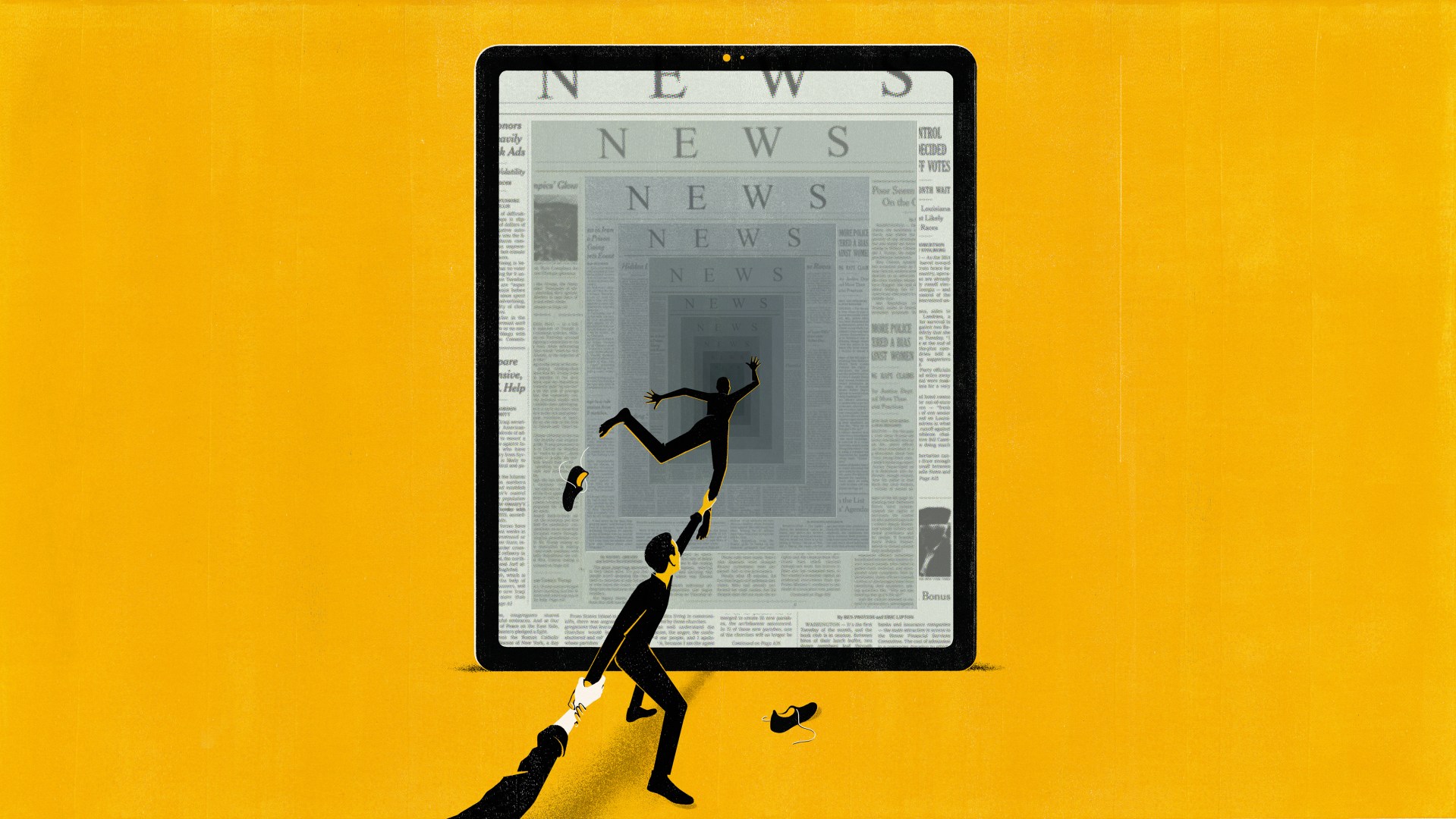At Bethel University in Minnesota, where I’m a professor of English and journalism, I often teach a course for college seniors called “What Good is Leisure?” (Many students who sign up mistakenly believe they’re in for a restful three-credit experience.) It’s a course about “the architecture of time,” to use Abraham Heschel’s phrase, and my students this year were more responsive than ever to the flabbiness of their calendar.
Reading the Times: A Literary and Theological Inquiry into the News
InterVarsity Press
200 pages
$14.99
COVID-19 had destroyed the rhythm of their weeks. It had beckoned them to spend hours doom-scrolling on social media, while giving them nothing to look forward to. They felt guilty and frustrated about what T. S. Eliot, in one of his poems, called “the waste sad time / Stretching before and after” their experiences of quarantine.
In reality, the pandemic has merely intensified the challenges of community, attention, and time that Jeffrey Bilbro addresses in his fine new book, Reading the Times. The underlying problem is this: We are learning to love the wrong things. Our news feeds are miseducating our desires. Whether our favorite media lean left or right—and even if we sample from both sides—we are becoming prisoners of the news cycle. Far from achieving the enlightenment we need to interpret our times, we are bloated from bingeing on our daily media buffet.
Although Bilbro’s subtitle is A Literary and Theological Inquiry into the News, he denies that the media is the source of the problem. Instead, he blames the bad habits we bring into our encounters with the news. These habits manifest themselves in three ways: associating too much with those who interpret daily events as we do, rather than with actual communities; developing a taste for sugary, unsubstantial entertainment, rather than giving attention to significant works of art, literature, and journalism; and submitting to the charms of the moment, rather than seeking to understand time within the sweep of God’s divine drama.
These three areas—community, attention, and time—form the three sections of Bilbro’s book. Each section analyzes one area and concludes with practical suggestions, or “liturgies” (as he calls them), to reshape our habits.
Reading and belonging
Reading the Times is written primarily for North American Christians who are concerned and bewildered by the events of the past several years—which probably includes you, right? Bilbro’s style is accessible, and though he drops into the occasional philosophical byway, he shows the way out as well.
We are often told that the solution to our democratic challenges is an improved media. In other words, we need more fact checkers, more diverse sources, higher journalistic standards, or a return to the Fairness Doctrine, which used to require broadcasters to air competing points of view. To be sure, Bilbro helpfully lists the media he trusts at the end of the book. But the surprising heart of his analysis comes in his section on community: “Our thinking,” he writes, “is downstream from our communal belonging. Instead of looking to the news to create better communities, we should be looking to strengthen communities so that they can create better news.”
Bilbro argues convincingly that our media choices create de facto communities—artificial communities, really—and that we need to question our identification with them. He quotes Turkish writer and sociologist Zeynep Tufekci’s observation that “belonging is stronger than facts.”
To illustrate, he observes the travel cruises hosted by media organizations like National Review and NPR. The New York Times beckons you to join “like-minded travelers on journeys around the world.” My Minnesota affiliate of NPR endlessly proclaims its journalistic balance—but my informal 2008 count of cars with a bumper sticker for both Minnesota Public Radio and a presidential candidate showed this result: Obama 26, McCain 0. I just hope they don’t overload the port side during their cruise.
Bilbro claims that we’re susceptible to “alternative facts” when we belong more to our favorite media than to the places and communities where we live. I think he’s right. On the other hand, the role of media in overcoming American individualism and creating public spirit has been noticed as far back as Tocqueville’s Democracy in America (1840), and Bilbro by no means discounts its positive role. He reads The Atlantic, The American Conservative, Christianity Today, First Things, and Commonweal, along with online sources such as the Rabbit Room, Christ and Pop Culture, and Front Porch Republic (where he serves as editor). He listens to NPR, Mars Hill Audio Journal, and The Witness. But he strongly recommends that we also read local media. “The point here is to avoid consuming the news as an isolated spectator,” he writes. Instead, he wants readers to integrate their use of media into their actual involvement with real, local communities.
This brings me to a criticism of his otherwise strong section on community. He writes convincingly that national media have gained power because other forms of communal identity—such as “family, place, ethnic group, [and] religious tradition”—have weakened. For his likely audience, I believe Bilbro could have stressed the foundational element of religion more strongly.
Religion isn’t just one element among many. To simplify an insight from German Catholic philosopher Josef Pieper (whom Bilbro quotes several times): You can’t have a vibrant culture if you separate it entirely from religious practice. To go even further back, sociologist Emile Durkheim thought the very social character of human beings was created by religious observance. Bilbro’s book is deeply biblical and theologically astute. It doesn’t seek to be evangelistic—still less, polemical. Even so, I think this is a favorable time to explain the centrality of religion in our civic formation.
That brings me to time itself, the subject of the central section in Bilbro’s book. The communities to which we belong are also the places where we spend our time. One of his crucial themes is the distinction between two meanings of time, from the Greek words chronos and kairos. The news cycle runs according to chronos, which he explains as the chronological sequence of events. It is sequential and linear, always progressing forward. Kairos refers to the opportune moment for repeated acts, such as planting and harvest. It is cyclical and accommodates little that is new or changing.
Neither of these approaches is complete on its own, he writes: The adherents of chronos believe they can discern a “right side of history”—namely, their own—while cultures shaped solely by kairos often show little care for the day-to-day experiences of their people. Our task as Christians, writes Bilbro, is to read the times in light of “the crucified and risen Word … to discern how [God] might be calling us to participate in his ongoing work of redemption.”
Bilbro’s biblical examplar of such a relation to time is the prophet, who participates in both chronos and kairos but whose ear attends to the Word of God. In the practical, “liturgies” part of this section, he offers suggestions for reviving the liturgical year and the “daily office” of prayer from historic Christian traditions.
I’m surprised that he doesn’t mention the most obvious and accessible mode of reordering time: the revival of Sabbath practice. Jews relish the saying, attributed to the Hebrew writer Ahad Ha’am, that “more than Jews have kept Shabbat, Shabbat has kept the Jews.” This saying holds deep significance for Christians too—not just as individuals but as communities.
My students have responded favorably to books on Sabbath by Abraham Heschel and the Christian spiritual writer Mark Buchanan, but by far their favorite activity from my “Leisure” course is creating a 24-hour, digital-free Sabbath. They use words like “liberated” and “free” to describe their experience, and they inevitably describe richer conversations, more fulfilling exercise and hobbies, and even more satisfying mealtimes.
Redirecting our attention
The other section of Reading the Times centers on “attention.” Coming early in the book, this section asks readers what they are attending to, listening to, and reading. From the very beginning, Bilbro introduces us to great works of literature that he’s been reading and art that he’s been viewing. In some ways, the entire book is a tour of Bilbro’s reading. In this respect, it is similar to Alan Jacobs’s recent book Breaking Bread with the Dead. Both books try to help readers reshape their desires, first by providing a critique of today’s information overload and its tendency to reinforce the prejudices of the present day; and second, by redirecting our attention to works of the past that have prophetic resonance for our day.
Bilbro’s treatment of his key authors and artists is one of the book’s great pleasures. He opens with Henry David Thoreau, who warned that “the mind can be permanently profaned by the habit of attending to trivial things.” Sustained treatments of Thomas Merton, Wendell Berry, Dante, Marc Chagall, and Pieter Bruegel the Elder punctuate the text. Throughout, his engagement with current and past commentators is intelligent, fair, and irenic.
Bilbro closes his analysis with treatments of Frederick Douglass and Dorothy Day. Both founded publications that “sought to create the news from the perspective of [oppressed and marginalized] communities,” he writes. By joining their efforts with those of fellow Christians, they gradually created communities of readers whose shared practices served as faithful, public manifestations of the gospel.
Since I began reading the book, I noticed conversation after conversation in which my friends, colleagues, and students connected the frustrations of the past year to the things vying for their time and attention and to the increased pressures on the communities they love. With Reading the Times, Bilbro has brought those frustrations to the surface, analyzed them well, and given us hopeful ways to confront them.
Daniel E. Ritchie is professor of English and journalism at Bethel University in St. Paul, Minnesota.












